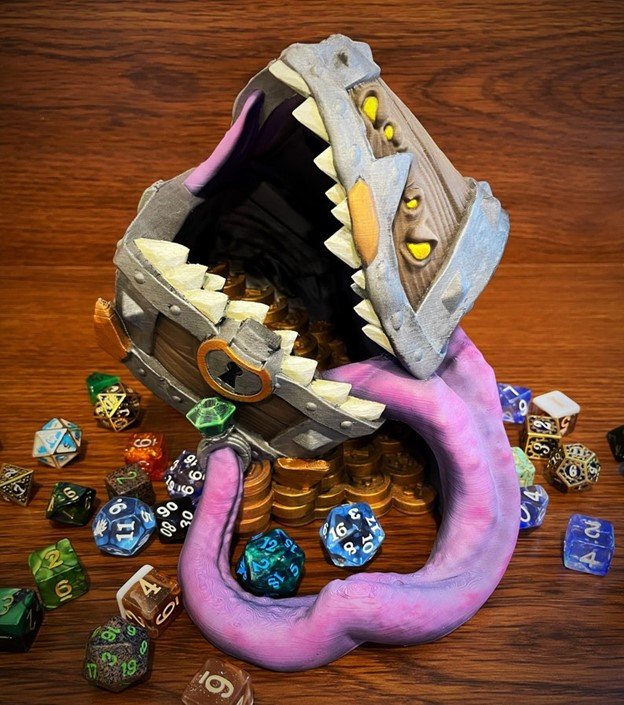RPG Mimics and Why We Deceive Others
What is the real life equivalent to the mimics in role playing games and why do we deceive others and ourselves
This article includes affiliate links. If you purchase through an affiliate link, I earn a small amount from qualifying purchases.
The light from the adventurer’s torch flickers across the scene before them. The lone chest, tucked against the stone wall in an overwise empty room. The paladin stands back, wary at the sight. But the greedy townsman accompanying him is far too eager. He steps quickly across the room, ready to add more coin to his purse. But as he touches the chest, the lid bursts open. His eyes go wide in shock at the opening, now exposing a gaping maw of dripping teeth. A tongue lashes out and grabs its prey, and with a vicious bite, the townsman is no more.
In role-playing games, the mimic is a polymorph that can disguise itself as everyday mundane objects. It may take many forms and remains motionless and unassuming, waiting patiently for its prey. After being victimized by repeated mimic attacks, adventures may become paranoid of attack and the appearance of vicious teeth behind every chest, door, and dungeon barrel.
“Sometimes a chest is just a chest, but don’t bet on it.”
- X the Mystic’s 3rd rule of dungeon survival. DnD Monster Manual 5th edition
In real life, we have versions of mimics as well. We call them posers, imposters, charlatans, fraudsters, etc. And the role of a mimic, whether in an RPG, or real life, is to disguise themselves as something they are not and gain from their deception, whether it be pretending to a treasure chest to earn a tasty meal or to deceive someone into giving away something that they desire.
Real Life Mimic Classes
Whereas RPG mimics may take many forms, human mimics can only disguise themselves as other versions of themselves. But while the illusion is less severe, RL mimics are no less dangerous. Here are some examples of the mimics that we may encounter in our real-life adventures:
Identify Fraud Mimics
These people steal the identity of and then pose as their victims to commit fraud and secure financial gains.
Sales Mimics
These mimics promote fake or fraudulent products, the proverbial snake oil salesman, touting their many unproven or false benefits.
Catfishing Mimics
Catfishing mimics portray themselves differently online to manipulate others into giving them money or entering into a false relationship
Social Media Mimics
These people have social media accounts full of fake images of a lifestyle of luxury and contentment to gain status or respect from others
Friendship Mimics
Emotionally damaging, these mimic act as our friends to our faces but then take advantage of, ridicule, or proverbially stab us in the back.
Depending on the class, RL mimic attacks can cause legal and financial losses as well as emotional damage. The psychological damage from their attacks may cause lasting damage, leaving us feeling distrustful of others and may lead to levels of paranoia and anxiety due to the deception. (Read more on trust in Why We Don’t Trust Others)
Why do people deceive us?
The most dangerous mimics are those that do so due to psychological reasons. Malignant narcissists, sociopaths, and psychopaths may be pathological liars and deceive others through various means. There are even some that get a thrill from it, in what psychologist Paul Ekman, calls “duping delight.”
“They muddy the water to make it seem deep.”
– Friedrich Nietzsche
Other people acting as mimics are looking to gain or preserve something they consider more valuable than their victim. For example, someone that deceives us into purchasing a faulty product believes their financial gain is more important than our safety or well-being. A false friend finds what they get by taking advantage of us is of greater importance than our friendship.
But often, the role of the mimic is less obvious. And sometimes, we’re the ones playing the part.
When We’re the Mimic
We like to think of ourselves as the hero of the story. But there are times that we also play the part of the deceiver.
We might tell someone that we like the same thing to try to form a connection with them. For example, at a party, we might say we also like 90’s music while someone is raving about how great it is. But perhaps, we’re actually more of a fan of the 80s than the 90’s sound.
To impress our new boss, we pretend to enjoy a hobby or sports that we have no interest in. Or to end a disagreement, we might say that we agree when we don’t feel the same way.
We don’t see it as being deceitful and may even think that we’re doing it for the sake of others. But similar to the other classes, we are doing so to gain or preserve something that we consider more valuable than the truth. We want to be liked by others, feel part of the team, and we may pretend to be something that we’re not to gain that feeling of acceptance. (Read more on self-acceptance in X-Men and The Power of Being True to Yourself)
“Most people are other people.
Their thoughts are someone else’s opinions, their lives a mimicry, their passions a quotation.”
- Oscar Wilde
But instead of feeling accepted, we are often left feeling misunderstood and lonely because they don’t know the real us. We are the ones to blame, depriving them of getting to know our honest thoughts and opinions. And we have also deprived ourselves of building genuine and deeper connections with others.
Birth of the Mimic
We are not actively looking to manipulate others and end up hurting ourselves. Why do we act like this?
Most mimics are born out of fear and lack of self-confidence. It may be a fear of losing money that drives someone to financial fraud. Or another is afraid of being unseen, or being a nobody, makes them feel it is necessary to falsify a life of luxury on social media. We may have similar fears, feeling it necessary to suck up to the boss or be accepted with others that we disagree with.
But one of our biggest obstacles is our lack of self-confidence. We don’t see ourselves as good enough as we are. Thinking our true nature is flawed and unworthy, we believe that others can’t possibly accept us for who we are, so we are driven to pretend to be someone else.
This lack of self-confidence drives our manipulation of others, hiding our true shape and form.
“Why pretend to be something you’re not If you have to be someone, be someone no one else is.”
- Terry Brooks
Mimic in the mirror
This deception can be turned inward as well. And one of the most well-disguised mimics is the one that we see in the mirror.
We tell ourselves falsehoods to avoid making changes in our lives.
We “love” our job but have an upset stomach every Sunday night thinking of the workweek
Our relationship is “perfect,” but we feel isolated and alone
A person is our “best friend,” though they only call because they need another loan
We’re “content” with being uncomfortable in a bathing suit but sigh over photos of couples at the beach
We may tell ourselves these things, the face smiling in the mirror, but that’s not the real us.
But in order to defeat this mimic, we need to face our fears. Understand that making changes is uncomfortable, and it’s hard. The future is unknown, and we can only accomplish great things if we are honest with ourselves. (Read more on facing our fears in D&D and Disabilities - My Quest for Trust in the Dark)
“The smiles of the unhappiest are often the widest.”
― Mokokoma Mokhonoana
Can a mimic ever have a good alignment?
Manipulation that is driven by fear creates monsters out of others and ourselves. But when we realize that the mimic is an illusion and not our true nature, we can remove the fear and self-doubt from the equation.
Children like to play pretend, trying out the lives of others on their journey of discovery. Similarly, we can imagine ourselves as others. We can try on new creative ideas and look for new pathways.
We can also try to imagine ourselves as others to understand them better and become more empathetic. It can help us be more open and appreciative of them.
“You never really understand a person until you consider things from his point of view .. .
until you climb into his skin and walk around in it.”
- Harper Lee – To Kill a Mockingbird
Using the polymorphic trait of the mimic, without the need to deceive, we can use it positively to improve ourselves and grow our connection to others instead of breaking it apart.
Conclusion
The next time you return to the dungeon with your adventuring party and find an elaborate chest. Approach it with caution. Put yourself mentally in the mind of the mimic and try to understand it. You might find some insight instead of just the monster.
And at the very least, you’ll gain advantage on your investigation check.
“The barkeeper asked why we carried weapons on us in the bar. I said “mimics.” The barkeeper laughed, the party laughed, the table laughed. We killed the table. It was a good time.”
- Internet meme
Author:
Laurie Trueblood is a writer and life coach that enjoys fantasy, science, psychology, and everything nerdy. As the founder of Adventures to Authenticity, her mission is to help others level up and become the best versions of themselves.
Read more about articles about trust: Why We Don’t Trust Others and D&D and Disabilities - My Quest for Trust in the Dark















